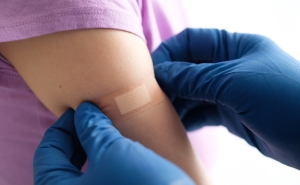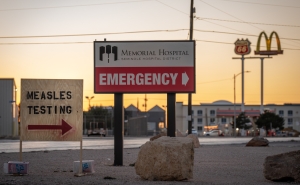What to Know About Malaria in the U.S.
The U.S. has recorded its first homegrown malaria cases in decades—but there’s no need to panic.

For the first time in 20 years, the U.S. has recorded homegrown malaria cases.
The country sees about 2,000–2,500 malaria cases each year linked to travel to malaria-endemic areas such as sub-Saharan Africa and parts of South America and Southeast Asia—but the nine locally transmitted cases seen so far this year were contracted by people who hadn’t recently traveled to these areas. Seven cases were recorded in Florida, and one each in Texas and Maryland.
Malaria experts say this handful of cases is no cause for panic—catching malaria in the U.S. is still highly unlikely. But they also underscore that if malaria and other diseases are re-emerging, or emerging in places where they haven’t previously been, it is a cause for concern.
Malaria's History in North America
In the early 20th century, “malaria was common even as far north as Cleveland,” says Prakash Srinivasan, PhD, MS, an assistant professor in Molecular Microbiology and Immunology and at the Johns Hopkins Malaria Research Institute.
The disease was endemic in the U.S. until the 1950s. In 1951, malaria was considered eliminated from the country.
Many factors contributed to achieving that status. Industrialization, the clearing of wetlands where mosquitoes breed, the use of insecticides and window screens—on top of public health measures like malaria-preventing drugs and improved diagnostics—were “game changers” in the U.S. and most other Western countries in terms of stamping out the disease, says Srinivasan.
Anopheles mosquitoes—the genus that carries malaria—is still present in the U.S. “But because malaria transmission in the United States has not been a big issue, there is no surveillance of Anopheles populations,” explains Photini Sinnis, MD, a professor in MMI and at the Johns Hopkins Malaria Research Institute.
The Vectors and the Parasites
Malaria transmission “is a relationship between a mosquito, a parasite, and a person,” says Sinnis. A female Anopheles mosquito must be infected with the malaria parasite in order to pass on an infection. But there are many variables.
The lifespan of an Anopheles mosquito is typically a few weeks to a month, and in that time female mosquitoes feed on blood, which they need as a source of energy to mature eggs. A mosquito will typically take a couple of blood meals during its lifespan. The malaria parasite can persist in the mosquito for weeks, so it does have the potential to transmit to multiple people—but “the chances are pretty low,” explains Srinivasan.
And that’s why we’re seeing isolated cases, and not clusters or larger outbreaks.
Another factor: Not all Anopheles species transmit malaria the same way.
“It's about how anthropophilic the mosquito is—how much it prefers to bite humans. Malaria parasites are very species-specific,” Sinnis explains. The various species of Anopheles in the U.S. will bite humans “maybe 30% to 50% of the time.” If a human is not available, they may bite a dog or another mammal instead, breaking the cycle of human infection.
The Anopheles mosquitoes found in sub-Saharan Africa, on the other hand, bite humans 98% of the time—making it far easier for the cycle of human infections to continue.
Another reason that not all malaria infections are the same: There are multiple malaria-causing parasites. The most deadly is Plasmodium falciparum, says Sinnis, which is most common in sub-Saharan Africa, where malaria kills over 600,000 people every year—95% of them children under age 5.
“It is estimated that one child dies of malaria every minute,” says Srinivasan.
Another malaria parasite, Plasmodium vivax, is more prevalent in South America and Southeast Asia and generally causes less severe disease—and is therefore less deadly.
How Malaria Likely (re)Appeared in the U.S.
Anopheles mosquitoes capable of carrying malaria are still very much present in the U.S.—they’ve just had very few opportunities to transmit the parasite because there are so few infected people to feed on.
Experts believe that this new spate of locally transmitted cases likely occurred because a specific set of circumstances aligned: A person infected with malaria traveled to the U.S. from a malaria-endemic area and was bitten by a local Anopheles mosquito, which picked up the parasite and then bit someone else, passing on the parasite.
While the case in Maryland is confirmed as linked to P. falciparum, those in Florida and Texas are believed to be linked to P. vivax, more likely originating in travelers from South America.
Symptoms and Treatments
Malaria causes flu-like symptoms like fever, body aches, vomiting, and chills. The disease can be treated with effective antimalarials and IV fluids, but it’s essential to catch it early.
A telltale sign of infection is cycles of fever every couple of days, which coincide with the life cycle of the parasite in the blood.
People in the U.S. needn’t panic, or even avoid spending time outdoors in hot and humid areas where mosquitoes thrive. But it’s worth knowing the symptoms and risks, Srinivasan advises: “If you have a fever, and they can't figure out why you have a fever, [and] if you spend a lot of time outside where there’s a lot of heat and humidity, [malaria] should be considered, particularly because when you catch it early, you can treat it.”
Without treatment, the disease can progress to very severe or cerebral malaria. “Once you reach the cerebral malaria stage, even after anti-malarial treatment, [the] mortality rate can be as high as 20% to 25%,” Srinivasan says.
Malaria's Expanding Territory and What We Can Expect in the Future
The U.S. does not currently have the conditions for a major outbreak, Sinnis explains. The country doesn’t have the species of mosquito that makes malaria so prevalent in sub-Saharan Africa—Anopheles gambiae. Plus, the cold of winter wipes out mosquito populations each year.
But conditions are becoming more favorable for malaria transmission. Warmer winters are giving the Anopheles mosquitoes an opportunity to start reproducing earlier—meaning that their populations grow to the point where they have a higher probability of biting an infected person who has been to a malaria-endemic area.
“These changes in the environment could be more conducive for these mosquitoes to establish a niche,” says Srinivasan. Plus, the uptick of travel since the downturn of COVID—and globalization in general—makes it easier for malaria to move around.
The post-COVID surge in travel has increased the reservoir for infection. Mosquitoes can reach new locations by “hitching a ride on cargo planes or ships, or passenger planes,” he says.
It remains to be seen whether more homegrown cases can be expected in the U.S. Sinnis says the next five years will be critical to understanding how much of a threat malaria really poses to the U.S. Either way, she hopes that this year’s cases will encourage more surveillance of Anopheles mosquitoes in the U.S.
“Is this just a random event? Or is this a harbinger of things to come? It may be that there are going to be sporadic cases here to stay. We don't know yet. Time will tell,” says Sinnis.
Annalies Winny is a producer and writer at the Johns Hopkins Bloomberg School of Public Health





